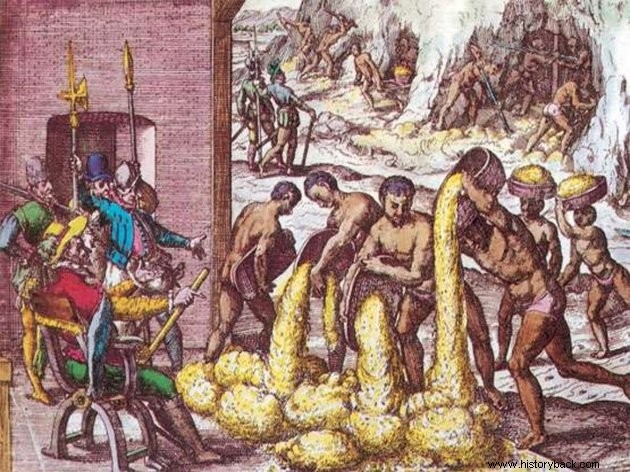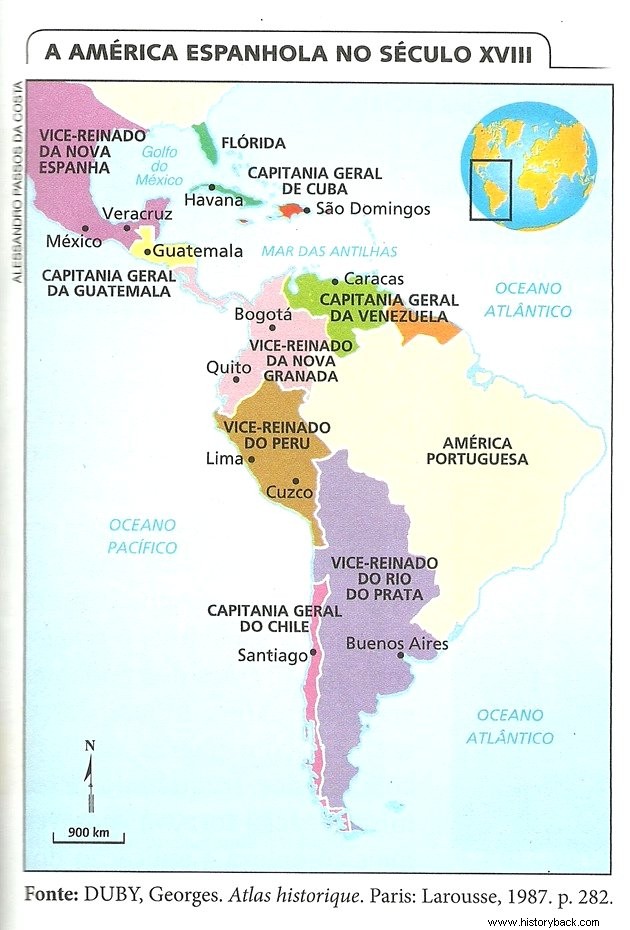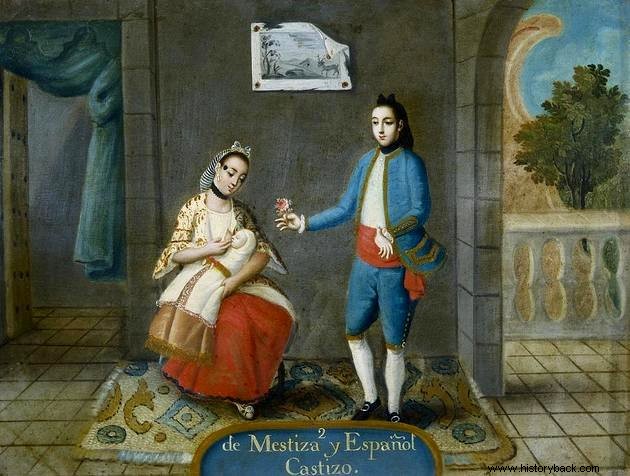The Spanish colonization in America was characterized by the modification of the political, economic and religious structure of the societies that inhabited that territory.
The Spaniards introduced a new religion, language, economic and social organization to the American continent.
For their part, they took a series of unknown products to Europe such as potatoes, corn and chocolate. Furthermore, the boundaries of the known world have expanded and changed forever.
Spanish Colonization in America
After the conquest it was necessary to occupy the American territory. After all, kings needed to dominate more regions and markets to legitimize their existence. Likewise, it wanted to expand the Catholic faith.
Political power guaranteed the spread of the faith, while the Catholic Church legalized the appropriation of territories. For its part, the bourgeoisie financed the taking of other people's goods in the name of the king.
The Capitulation it was the instrument that allowed the execution of these interests. In this document, the duties of each of the parties participating in the occupation of the new domain were established.
Thus, details were specified such as the capital to be used, the basic conditions of the expedition and how much money would be contributed by the Crown and by individuals.
See also:Discovery of AmericaEconomy of the Spanish Colonies

When settling in America, the Spaniards came across populations organized and governed by long-established laws.
Thus, in addition to its own rules, such as the encomienda , colonizers used local customs to take advantage of indigenous labor, such as the mita .
Order
The order it was an institution in force in the kingdoms of Castile and was adapted in the Indies (America).
The encomienda allowed the encomendero , a Spanish nobleman, to collect taxes in the form of work or material goods from a particular indigenous population. In return, the encomendero should evangelize, care for and defend them.
The orders they were hereditary but not perpetual. The abuses committed by many encomenderos led several religious orders to protest to the king.
In fact, the Spanish Crown tried to abolish it fifty years after its institution, generating revolt in several parts of the Viceroyalties.
The indigenous population itself rebelled against this system, as was the case with the revolt led by the indigenous Bartolina Sisa (1750-1783), in present-day Bolivia.
Mita
In the Viceroyalty of Peru, mainly, the colonizers took advantage of the mita , an Inca creation, in order to guarantee the work of the indigenous people for their purposes.
The mita consisted of a service provided by the male population to the Inca. Generally, it was about helping with the construction of temples and paths. In return, they received protection and offerings to the gods.
The Spaniards used this same idea throughout the territory of the Viceroyalty of Peru. In this way, the indigenous tribes were confined to the reductions and there they received the catechism. In order to pay for these costs, they had to perform the mita.
This generally consisted of employing part of the population in the exploitation of silver mines for a year.
Although work in the mines was regulated and was only supposed to be carried out for three weeks, the fact is that the harsh working conditions killed many indigenous people who were employed there as labor.
See also:Incas
Administration of Spanish America

To control the vast territory they had conquered, the Spaniards initially created two Viceroyalties, directly linked to the Crown:the Viceroyalty of New Spain and the Viceroyalty of Peru. The Captaincy General of Cuba, Captaincy General of Puerto Rico and the Captaincy General of Santo Domingo were also established.
It is important to note that these territories were considered as an extension of the Spanish kingdom, hence the name “viceroyalty”.
The metropolis had the following institutions to administer the colony:
House of Hiring
Responsible for registering all the people who went and settled in the Indies (America). Likewise, they wrote down the goods, the pilots came from navigation maps and still exercised justice. Initially, it was based in Seville and later in Cádiz.
Council of the Indies
It helped the king to make decisions concerning his dominions in America in terms of justice, economy and even during the war.
Actual Audience
They were the courts of justice established in the Viceroyalties and which judged the crimes committed by their inhabitants.
Vice-Kingdoms and General Captaincies
With the Enlightenment reforms undertaken by King Carlos III (1716-1788), in the 18th century, the viceroyalties were split into four and more General Captaincies were created.
The objective was to find a way to improve the colonial administration.
Vice Kingdoms :territories of great extension and population, were the most profitable for the Spanish Crown. They were ruled by a viceroy. They were:Viceroyalty of New Spain, Peru, New Granada and La Plata.
General Captaincies :were established in areas of greater conflict with the indigenous population or that were the target of pirate attacks. They were:Guatemala (which included the current countries of Guatemala, Honduras, El Salvador and Costa Rica), Cuba, Venezuela, Chile, Santo Domingo and Puerto Rico.
Political Offices in the Spanish Colonies
The colonies were administered by officials appointed by the sovereign himself.
- Vice King :it was the highest position within this structure and held by a noble or nobleman directly appointed by the King. He possessed maximum authority and some General Captaincies depended on him.
- Captain General :title used by those in charge of the General Captaincies.
- Governors :helped the viceroy or captain general to administer the territory.
- Cabildo :they were a kind of council formed by the owners and prominent men of society, including the clergy, and they met in a building of the same name.
Society in the Hispanic Colonies

Colonial society in Spanish America was marked by skin color. Over time, due to interracial unions, the place of birth would be more important than the degree of miscegenation. So we have:
Chapetones
So called the newly arrived Spaniards in the Hispanic colonies. They held high positions such as Viceroy, Captains General, Governors, Mayors or Intendants (mayors), bishops and archbishops, superiors of various religious orders.
However, their prerogatives were not hereditary, as if they had children born outside the metropolis, they would be considered criollos and did not enjoy the same social status as their parents.
Criollos
They were the children of Spaniards born in America. They could not occupy high positions, but they participated in the Cabildo and had a comfortable social position.
The criollos carried out various activities and were professionals such as lawyers, merchants, but also encomenderos , minesweepers, farmers, etc.
Contrary to the meaning in Portuguese, the word criollo , in Spanish, does not represent a black person. Indicates those whites who were born in America and not in the Kingdom of Spain.
Enslaved Blacks
The enslaved Africans were brought by English and Portuguese traffickers who had the participation of Spanish investors.
Enslaved people were used as labor to replace the decimated indigenous population in the Caribbean and forced to work on sugarcane, tobacco, cocoa, cotton, among other crops.
Black slavery was not homogeneous in Spanish dominions in America. It was heavily used in the Caribbean region, but less strongly in the Viceroyalty of Peru, for example.
On the other hand, its presence is almost not felt in the region of the Rio de la Plata.
See also:slave tradeIndigenous people
Spanish colonization meant the disappearance of the old way of life of native peoples.
The economy was reoriented towards the foreign market and the indigenous people worked especially in the silver, gold and mercury mines, but were also employed in domestic service and agriculture.
Over time, the original language was replaced by Castilian and the religion became Catholicism. Likewise, a belief is developed that mixes pagan practices with Christianity.
Even with all these changes, some customs remained and others merged, creating a new way of thinking and living. Others, unfortunately, were lost forever.
See also:First Peoples of AmericaMestizos
This was a society where skin color determined your place in the social hierarchy.
According to colonial customs, the union between a Spaniard and an indigenous woman gave rise to the mestizo. Despite this, mestizos were accepted because they were raised in a culturally white environment.
As time went by, indigenous people, whites, and blacks started to unite and generate children. This led to the emergence of people who did not fit into any of the above categories.
Thus, a series of specific words for each of these unions began to emerge. We can mention:mulatto, turn-back, morisco, wolf, sambaio, coyote, cambujo, chamizo , etc.
It was a way of establishing new categories, but still the status of each mestizo was ambiguous and depended on how white their skin color and customs were.
See also:Latin AmericaCountries Colonized by Spain
There are many territories that were occupied by the Spanish in America. Let's see:
Uruguay, Paraguay, Bolivia, Argentina, Chile, Peru, Ecuador, Colombia, Venezuela, Panama, Honduras, Cuba, Dominican Republic, Costa Rica, Nicaragua, Guatemala and Mexico.
In addition, the Spaniards populated some Caribbean islands that later passed into the hands of other settlers such as Jamaica, Trinidad and Tobago, Guadeloupe or Saint Kitts and Nevis.
Likewise, much of what is now called the United States was part of the Viceroyalty of New Spain and included the current states of California, Texas, Florida, Nevada, Colorado, Utah, Arizona, Texas, Oregon, New Mexico, Washington, and parts of Idaho, Montana, Wyoming, Kansas, Oklahoma and Louisiana.
See also:Independence of Spanish America